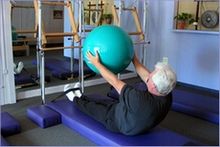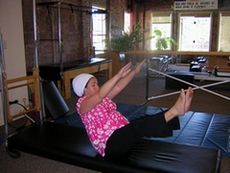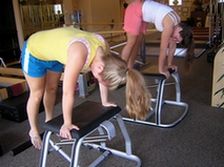FREQUENTLY ASKED QUESTIONS ABOUT PILATES
Pilates: Everyone’s talking about it, but what the heck is it?
Why is it so good for you?
Who can practice Pilates?
 Pilates
is suitable for all fitness levels, body types and ages
Pilates
is suitable for all fitness levels, body types and ages
However, as with any new exercise routine we recommend that you get the approval of your doctor first. Pilates isn’t just for the people who want to be fit and trim: it was also designed especially for people who need extra help for recovery.
What is a 1st and 2nd generation Pilates Instructor?
Is Pilates aerobic?
How is Pilates different from yoga?
Yoga focuses on holding the body in certain exercise positions, including positions that are very difficult, to stretch the body. Pilates exercises involve less complicated routines, more repetitions and more flowing movement. This means that Pilates is more accessible to more people, of different ages and fitness levels, and that results occur faster. Both disciplines share a philosophy of body and mind connectedness and emphasize proper breathing.
Will I lose weight?
Can Pilates help to relieve back pain?
Can Pilates help during my rehabilitation?
For
people unfortunate enough to get injured, Pilates is the perfect
post-rehab method to keep the supportive musculature in condition while
healing and after. If they are recovering from illness, then Pilates
can be a safe form of exercise during difficult times. With an emphasis
placed on breath, body alignment, control and overall
form, Pilates is an excellent complement to most
rehabilitation
programs.
It’s gentle on the joints and can be beneficial to people with
arthritic conditions.
Pilates is
beneficial to those with certain neurological
conditions in particular Parkinson's disease, Multiple Sclerosis and
Post CVA (stroke).
The
unique qualities of a Classical Pilates exercises program will
accelerate the healing process!
Can Pilates help against osteoporosis?
Osteoporosis is a condition in which the bones become weak and can break from a minor fall or, in serious cases, from a simple action such as a sneeze. According to the National Osteoporosis Foundation, Osteoporosis is a major public health threat for an estimated 44 million Americans, for 55 percent of the people 50 years of age and older. In the U.S. today, 10 million individuals are estimated to already have the disease and almost 34 million more are estimated to have low bone mass, placing them at increased risk for osteoporosis. While osteoporosis is often thought of as an older person's disease, it can strike at any age. Among the steps to prevent the disease, the Foundation recommends to be engaged in regular weight-bearing and muscle-strengthening exercise. By improving strength, balance and flexibility Pilates can actively help. However, people with low bone density or already affected by the disease must defer to their physician in establishing which exercises are safe and appropriate for them. In American Cassical Pilates de Paris, we are trained in the appropriate modifications needed for those with low bone mass or osteoporosis.
Is Pilates good for seniors?

Is Pilates helpful for golfers?
Golfers getting into swing of fitness regimen
Does Pilates relieve stress?
Can I do Pilates when pregnant?
 In American Classical
Pilates de
Paris, we are not in favor of women starting
Pilates during their pregnancy. However, those who
have
already been practicing Pilates on a regular basis we strongly
encourage them to continue with approval from their physician.
Pilates is a
gentle low impact form of exercise and as such it is
considered one of the best forms of exercise for a pregnant woman.
Pilates strengthens the most important muscles women will use during
pregnancy and labor. Pregnant Pilates will build abdominal, back and
pelvic muscles that will support you through you pregnancy and
delivery. Pilates is not only a safe form of exercise while pregnant,
it can be hugely beneficial too! So
include Pilates in your plans before the baby! You'll be glad you did! So
will she or he!
In American Classical
Pilates de
Paris, we are not in favor of women starting
Pilates during their pregnancy. However, those who
have
already been practicing Pilates on a regular basis we strongly
encourage them to continue with approval from their physician.
Pilates is a
gentle low impact form of exercise and as such it is
considered one of the best forms of exercise for a pregnant woman.
Pilates strengthens the most important muscles women will use during
pregnancy and labor. Pregnant Pilates will build abdominal, back and
pelvic muscles that will support you through you pregnancy and
delivery. Pilates is not only a safe form of exercise while pregnant,
it can be hugely beneficial too! So
include Pilates in your plans before the baby! You'll be glad you did! So
will she or he!








